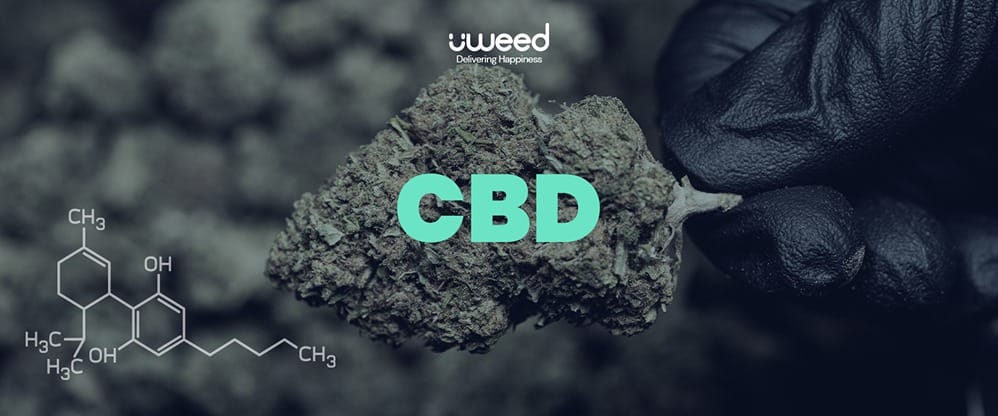What is CBD? Definition and Overview of Cannabidiol
You’ve probably heard of Cannabidiol or even already decided to buy CBD online. This famous substance extracted from the cannabis plant has gained popularity worldwide. This molecule is attracting increasing interest, especially for its potential benefits for health and well-being. But do you know what CBD is or what it’s used for? Is it still unclear to you? Then you’re in the right place! We have prepared an exciting exploration into the fascinating world of Cannabidiol in this comprehensive guide.
Table of contents of our Cannabidiol article
- CBD Definition: What is Cannabidiol?
- The Science Behind C annabidiol
- CBD, THC, Hemp or Marijuana: How to Distinguish Them?
- CBD and the Effects on our Human Body
- Beneficial Effects and Medical or Therapeutic Applications of CBD
- CBD in well-being and relaxation
- Possible side effects of CBD
- Is CBD legal?
- Consumption of CBD products
- CBD for Pets: Can Cannabidiol Help Animals?
- The dosage of CBD
- Future perspectives
CBD Definition: What is Cannabidiol?
The term “CBD” is the acronym for Cannabidiol. Indeed, it is one of many active compounds, known as cannabinoids, present in the Cannabis sativa L plant, also called hemp.
Unlike its psychoactive cousin, Delta-9-Tetrahydrocannabinol (THC), ingesting or topically applying Cannabidiol does not lead to euphoria or alterations in consciousness. So take a deep breath: there’s no risk of getting ‘high’ with CBD!
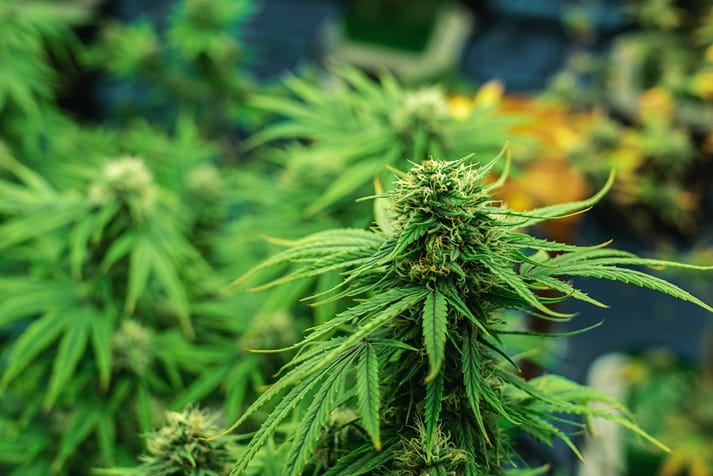
The History of Cannabidiol
The history of Cannabidiol has ancient roots. The first documented uses of cannabis date back nearly 4000 years before our era in China. This versatile plant has been valued for its medicinal virtues for centuries.
However, it was not until 1940 that Dr. Roger Adams and his team at the University of Illinois isolated Cannabidiol. Nevertheless, the exact structure of CBD was discovered in the 1960s through the work of the Israeli researcher Raphael Mechoulam.
Since then, CBD has gained widespread recognition and notoriety. It is now entering various industries related to well-being and health, from dietary supplements to cosmetic products and alternative therapies.
The Science Behind Cannabidiol
Understanding the scientific principles of CBD is essential before examining its benefits and medical applications.
Chemical Composition of Cannabidiol
CBD, also known as Cannabidiol, is a star in the family of cannabinoids, those chemical compounds found in Cannabis sativa L. So, what exactly is CBD? Its uniqueness lies in its non-psychoactive structure. Unlike its cousin, THC, it doesn’t make you ‘high’! This molecular marvel consists of 21 carbon atoms, 30 hydrogen atoms, and two oxygen atoms, weighing approximately 314 g/mol.
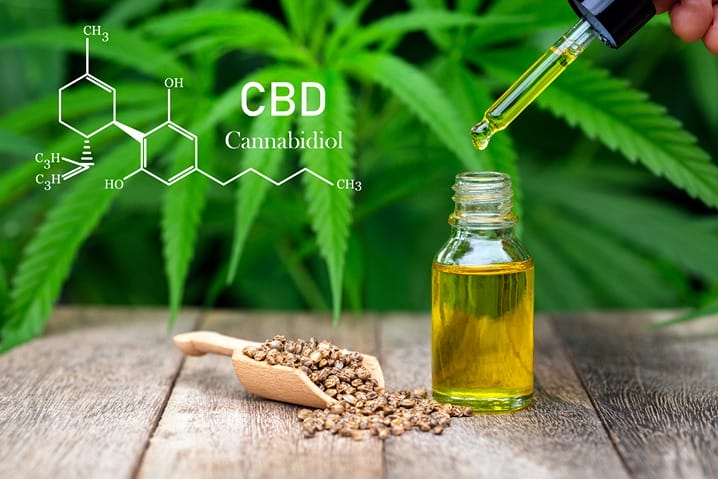
Cannabinoids: Interactions with the Human Body
Cannabinoids, including the prominent CBD, play a crucial role in interacting with the cannabinoid receptors of the human body. Secreted by the cannabis plant, they activate the endocannabinoid system present in all mammals. They induce effects on the brain and the central nervous system. There are more than a hundred different cannabinoids.
Researchers have studied these molecules for centuries for their diversity and potential effects. CBD, in particular, has attracted scientific attention for its possible therapeutic benefits for the human body. And that without the psychoactive effects associated with other cannabinoids like THC (Tetrahydrocannabinol), CBN (Cannabinol), CBG (Cannabigerol), and CBC (Cannabichromene).
Methods of Extraction and Purification
Now that you understand CBD’s chemical composition better, let’s examine its extraction. Here are the main methods that can be used:
1. Supercritical CO2 Extraction: This technique uses CO2 from the cannabis plant under high pressure and low temperatures. It’s a very efficient but also costly method. It allows for precisely extracting CBD and other cannabinoids without damaging the plant.
2. Solvent Extraction: This method involves heating and filtering steps to dissolve the active compounds of cannabis in solvents like ethanol.
The subsequent purification is then used to remove other cannabinoids like THC or any undesirable substances that might be present. As you can see, the process is more complex than it first appears!

CBD, THC, Hemp or Marijuana: How to Distinguish Them?
In our continuation of exploring cannabis, we now address a crucial topic: the distinction between CBD, THC, hemp, and marijuana. This section aims to clarify these often-confused concepts, highlighting their specificities and legal implications. Whether you’re a novice or a connoisseur, this information will help you navigate confidently in this world.
What are the Differences Between CBD and THC?
CBD and THC, two significant compounds of cannabis, have notable differences. CBD is non-psychoactive and offers therapeutic benefits without inducing euphoria, making it helpful in treating various medical conditions such as epilepsy, depression, and anxiety. It does not cause addiction or habituation. THC, on the other hand, causes euphoria and relaxation due to its psychoactive effects but can also cause side effects such as memory disturbances and anxiety.
According to Stéphanie Caillé-Garnier, a neurobiologist specializing in addiction at the CNRS, research suggests that CBD may reduce the addictive effects of various substances (such as THC), influence anxiety levels, and decrease specific stress-related reactions.
The distinction between CBD and THC is crucial for understanding their applications and benefits in a medical and therapeutic context.
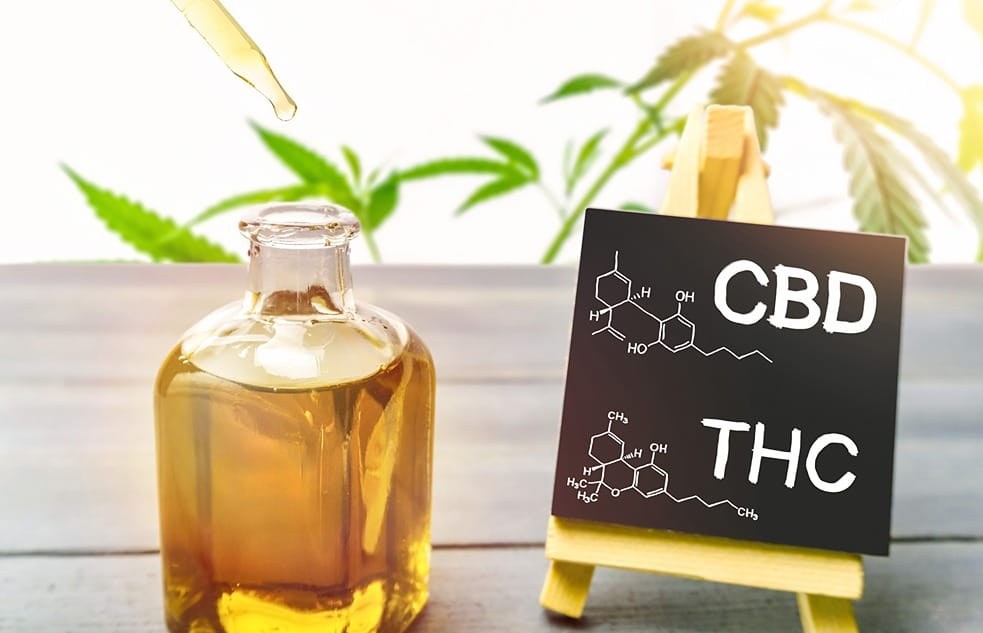
What is the difference between Hemp and Marijuana?
This topic can be confusing, especially when the distinction between the two is subtle and unclear. Hemp and marijuana both belong to the same plant family, Cannabis Sativa. Newcomers often mistakenly use the terms “hemp” and “marijuana” interchangeably. In short, hemp is sometimes called marijuana and vice versa, but both are correctly called cannabis and contain Cannabidiol.
Hemp and Cannabis Sativa
Cannabidiol is mainly present in cannabis plants and flowers with a high genetic concentration of CBD.
Here’s a more straightforward explanation: Hemp is a variation of Cannabis Sativa specifically cultivated for industrial applications. They include CBD oil, seeds, fiber (for clothing manufacture), paper, and fabric. Indian hemp contains deficient levels of THC compared to marijuana. It is, therefore, completely legal and safe.
Marijuana
In contrast, marijuana is a robust, small plant (not exceeding 1.5 m in height) that growers must raise in a controlled environment. It is grown for its glands or trichomes, which grow on the leaves and heads, to extract the grass, marijuana, or whatever you want to call it. However, their chemical composition is the most significant difference between the two. The marijuana plant has substantial levels of THC and shallow levels of Cannabidiol. This is the opposite of hemp plants used for CBD production.
In summary:
HEMP
Low THC content, slender and tall plant of 5-6 meters in height, grown for industrial applications, especially hemp oil. The hemp plant is legal and available for online orders.
MARIJUANA
High THC content, 1-1.5 meters in height, resembling a robust bush, grown for its resin-rich glands or aromatic trichomes. The marijuana plant is illegal in Switzerland and, therefore, not available for delivery.
CBD and the Effects on our Human Body
The benefits of CBD (Cannabidiol) for the body are undeniable. From pain relief to combating anxiety, its potential is immense. But how exactly do these effects occur? The answer lies in the interactions of CBD with our endocannabinoid system and other bodily processes.

The Endocannabinoid System and Cannabidiol
To understand the interaction between CBD and our body, it is first necessary to explain the “Endocannabinoid System.” This system, present in every human organism, is a complex system that plays a crucial role in regulating various bodily functions, ranging from sleep to mood to memory.
The endocannabinoid system produces compounds called endocannabinoids that interact with receptors CB1 and CB2 in our brain, organs, skin, and other tissues.
This is where CBD comes into play: It influences this system but does not directly bind to it. CBD increases natural endocannabinoid levels and inhibits certain enzymes responsible for their degradation. This allows for finer and more sustainable regulation of various biological systems.
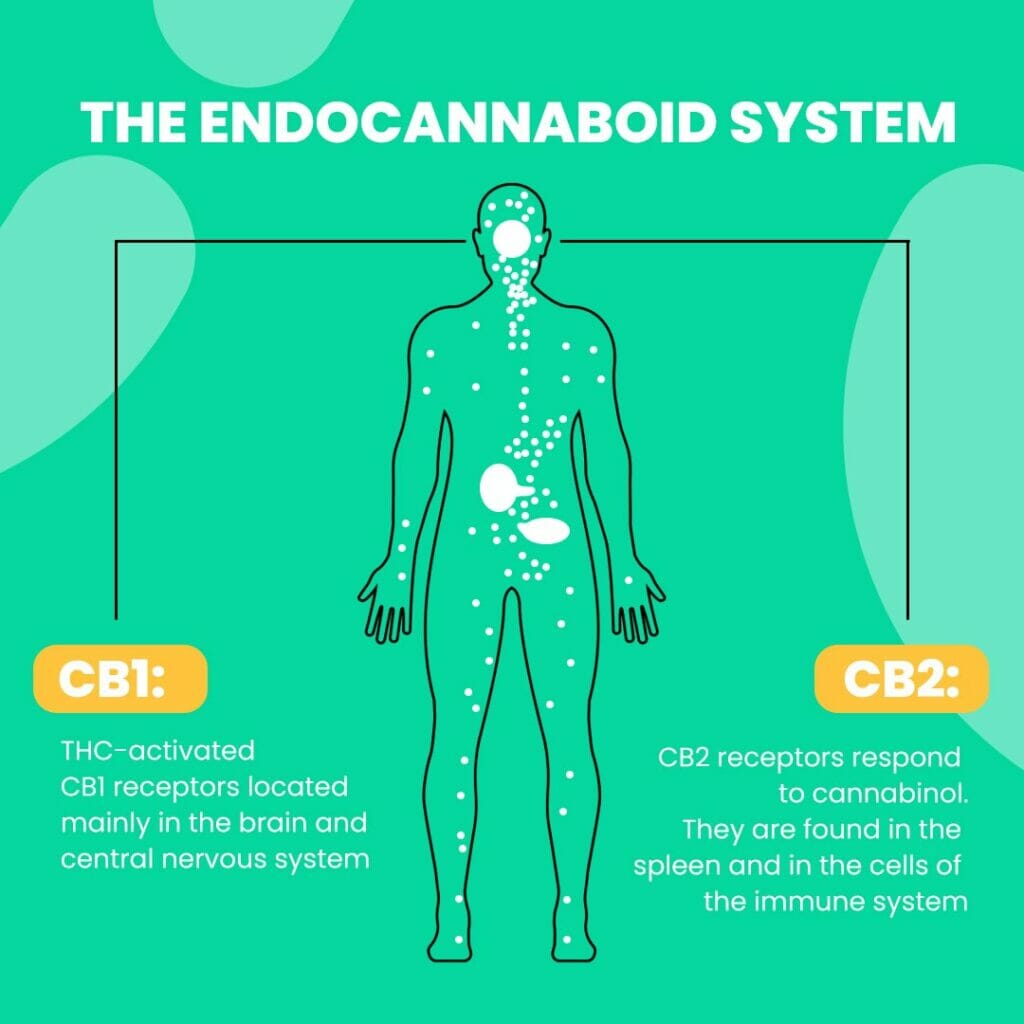
Interaction of CBD with the Body
How the CBD molecule interacts with our organism goes beyond the sole endocannabinoid system. Although this interaction is the most researched, the interaction of CBD with other receptors in the body is now recognized as essential for producing its effects.
Among these are notably the serotonin receptors (a neurotransmitter that regulates mood and behavior) and the TRPV1 proteins involved in perceiving pain and inflammation.
These diverse interactions thus offer an exciting range of different benefits of CBD and potential therapeutic applications.
Research on CBD and the Brain
The interaction of CBD with our brain arouses particular interest. Preliminary research suggests that Cannabidiol might have neuroprotective properties, helping to preserve and restore brain health. These results open up promising perspectives for the use of CBD in treating certain neurodegenerative diseases such as Alzheimer’s or Parkinson’s.
Furthermore, it is assumed that the positive interactions between CBD and brain receptors explain its calming effect against anxiety and its ability to improve sleep quality.
It must be emphasized, however, that much remains to be discovered about the effects of CBD on the brain. Researchers continue their investigations to clarify the relationships between CBD and our organism fully.
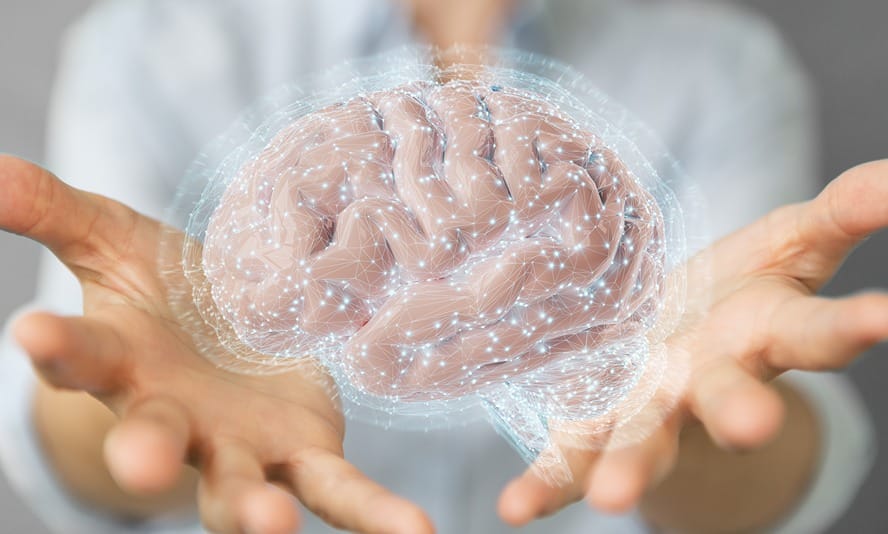
Beneficial Effects and Medical or Therapeutic Applications of CBD
When diving into the extensive world of Cannabidiol, a question naturally arises: What can CBD do for our health? Together, let’s explore some areas where CBD has shown promising results.
Pain relief

Historically, the primary use of the cannabis plant was pain relief. This has not changed over time; we only better understand why.
As previously explained, the human body has a sophisticated “Endocannabinoid System” or ECS. The ECS is involved in various processes, such as pain perception. Cannabinoids like CBD interact with this system, explaining their analgesic potential. According to recent studies, these interactions can reduce inflammation and produce a calming effect.
Treatment of anxiety and depression
Anxiety and depression are two common mental illnesses that can have devastating effects on our overall health. Many studies suggest that CBD could help manage these disorders by interacting with serotonin receptors in our brains. Serotonin is essential for our psychological balance; its dysfunction is often associated with these diseases.

Combating Insomnia and Sleep Disorders

Sleep is crucial for our overall health. Poor sleep quality can lead to various problems, from irritability to poor cognitive performance. The CBD molecule could help regulate sleep and wake cycles, thus contributing to more restorative sleep.
CBD and neuroprotection
Ongoing research on CBD has also opened discussions about its potential as a neuroprotective agent. This means that CBD could exert a protective function on our nervous system, potentially helpful in conditions such as certain forms of epilepsy, multiple sclerosis, and Alzheimer’s disease.
CBD and cardiovascular health
It also appears that our cannabinoid friends could benefit our cardiovascular system. Research has shown that using CBD can lower blood pressure, one of the main risk factors for heart disease.

CBD and skin health
We have also noticed a growing interest in using CBD-containing products for skin care. Due to the anti-inflammatory and sebostatic (sebum-regulating) properties of Cannabidiol, it is used in various creams and lotions to alleviate skin disorders such as acne or psoriasis.
Despite these promising results, it is essential to note that further clarification and more in-depth research are required for a solid validation of the effects of this cannabinoid. So, consult your health professional before integrating new components into your health regime.
CBD in well-being and relaxation
Cannabidiol, better known by its abbreviation CBD, plays an increasingly recognized role in the world of well-being. Its applications go beyond relaxation to stress management, skin care, and sports.
Use of Cannabidiol in stress management
Managing stress can be a real challenge in our modern world, where everything races. Here is where the potential of CBD comes to the forefront.
Current studies indicate that Cannabidiol possesses relaxing properties that help calm the central nervous system. It is, therefore, commonly used as a natural alternative to combat anxiety and promote relaxation.
Benefits of CBD for skin and beauty
Beyond its relaxing function, did you know CBD in cosmetics is gaining significant importance? Thanks to its anti-inflammatory and antioxidant properties, this hemp extract is now found in various CBD-based products for the care of our skin:
- Moisturizer, ointment, balm
- Facial and massage oil
- Detox mask
Thanks to these topical applications of CBD, those looking to improve the appearance of their skin can benefit from the advantages offered by this versatile component. Many report the effectiveness of CBD on skin problems like acne, eczema, or psoriasis.

CBD and Sports: Promoting Sports Recovery
The use of Cannabidiol is not limited to stress management and skin care. CBD is attracting attention in the sports field for its potential in post-exercise recovery.
CBD helps relieve muscle pain and promotes good recovery by assisting the body to rebalance after intense training. Whether it’s about easing muscle soreness or quickly regaining energy, the role of CBD in sports is no longer to be overlooked.

Possible side effects of CBD
As with any consumer product, the use of Cannabidiol (CBD) can cause undesirable effects in some people. Not everyone will experience these symptoms, but it is essential to be aware of them to be prepared and informed.
Some users may experience the following side effects when using Cannabidiol:
- Dry mouth
- Fatigue or drowsiness
- Diarrhea
- Appetite changes
Don’t panic! These effects are rarely severe and are often related to an overdose (remember to reduce the dose to make them disappear). They usually decrease over time as your body gets used to CBD.

Precautions and contraindications for taking CBD
When it comes to CBD, caution is better than recklessness. Here are some measures to safely use products containing CBD:
1. Consult a healthcare professional, especially if you have underlying medical conditions or are taking medications regularly.
3. Driving under the influence of CBD: Although CBD does not have the psychoactive effects of its cousin THC, it can cause drowsiness and relaxation, thereby increasing the risk of accidents. Be cautious on the road to avoid legal penalties.
2. Caution for pregnant women: To date, there is not enough reliable data on the use of CBD during pregnancy or breastfeeding
4. Be careful when purchasing: Always ensure that your product contains Cannabidiol (CBD), is not contaminated with THC or other substances, and has been subjected to third-party testing.
Overall, Cannabidiol (CBD) is generally well tolerated and causes few side effects, but it is still advisable to exercise caution when using it. Remember this simple rule: When it comes to CBD, it’s always better to be safe and calm.

Is CBD legal?
We are often confronted with the question: “What exactly is CBD, and… is it even legal in Switzerland?” Let’s look at this from different angles.
Legal status of CBD in Switzerland
In Switzerland, CBD products are legally allowed to contain up to 1% THC, a threshold higher than in many other countries. This liberal regulation facilitates the use and marketing of CBD while ensuring legal compliance. The CBD products offered in Switzerland, including those from uWeed, meet strict quality standards, ensuring purity, safety, and traceability.
Consumption of CBD products
The frequently asked question: “What exactly is CBD, and how is it consumed?” The possibilities are varied. We have offered you a wide range to meet your unique needs.
Various Forms of CBD Products
There is a wide range of hemp and cannabis-based products on the market. Cannabidiol can be taken mainly in the form of:
CBD Flowers and Small Buds
For lovers of traditional dried herbs, CBD flowers offer an exciting alternative for smoking or vaporizing. You can also use these CBD flowers to make culinary preparations or CBD hemp tea.
CBD Resins, Pollen, Hash
CBD resins, pollen, or hash are cannabis concentrates known for their high Cannabidiol (CBD) content and low THC levels. These products are made by extracting and compressing the trichomes, those tiny resinous crystals on the cannabis flowers, thereby concentrating their beneficial compounds. Their texture varies from solid and compact for resins to fine and powdery for pollen. CBD hash is especially appreciated for its rich aroma and moldable consistency. These products offer an intense and aromatic experience, ideal for those seeking a powerful alternative to traditional CBD flowers.
CBD oils
CBD oils are perhaps the most common form of Cannabidiol. They are easy to integrate into your daily routine and can be taken orally or applied to the skin.
CBD cosmetics
The market also offers a wealth of creams, lotions, and other body care products infused with CBD and known for their recognized anti-inflammatory properties.
Produits comestibles au CBD
Unfortunately, CBD-filled edibles are not authorized in Switzerland. Did you know you can enjoy foods like CBD chocolate, CBD candies, or drinks containing CBD? In addition to those mentioned above, there are many other CBD-based products: CBD capsules CBD tablets… the options are almost endless.

E-cigarettes and E-liquids for Vaping
The e-cigarette, CBD vape, or CBD puff offers another practical way to introduce CBD
into your system. However, inhalation has its risks and is not recommended for everyone.
CBD for Pets: Can Cannabidiol Help Animals?
With all the buzz around this cannabinoid, CBD for pets is becoming as popular as it is for humans. For most pet owners, however, administering a drug or supplement to their pet raises some questions. And that’s completely normal.
Since Cannabidiol is still relatively new in the world of pets, most veterinarians are not yet trained in its use nor always willing to recommend or prescribe it. Administering CBD to your dog or cat is possible, but choosing the right oil that suits them is essential.
For this reason, we have created a quick-start guide. This guide explains the use and dosage of Cannabidiol for animals, especially cats and dogs.
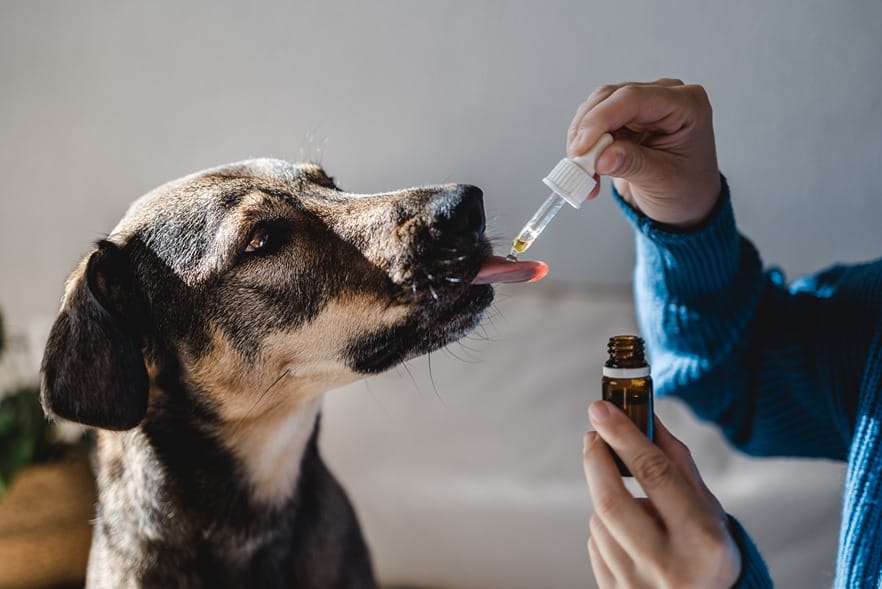
The dosage of CBD
Many people and users have difficulty finding the proper dosage for Cannabidiol. Indeed, it can be challenging to know which amount to use at the beginning of the effective dosage for their complaints.
The problem with the dosage of Cannabidiol is that there is no “correct” dosage that works for everyone. However, it is always recommended to start with a low dose and then slowly and gradually increase it, beginning with a dose of 25 mg CBD taken twice daily. If necessary, the CBD dose can be increased every 3-4 weeks by adding another 25 mg daily until the symptoms are relieved. However, if you experience undesirable side effects, decrease the dose by 25 mg.
For more specific recommendations and considerations on the dosage of Cannabidiol, check out our guide on CBD dosage.
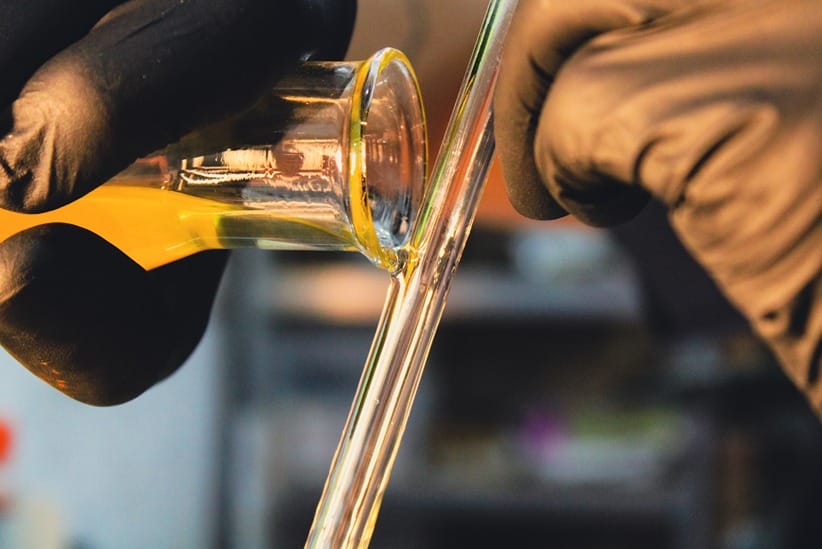
Future perspectives
The future of the health and wellness industry is inextricably linked to the development of cannabis products, especially Cannabidiol (CBD). We are witnessing a real green revolution, of which we have only seen the tip.
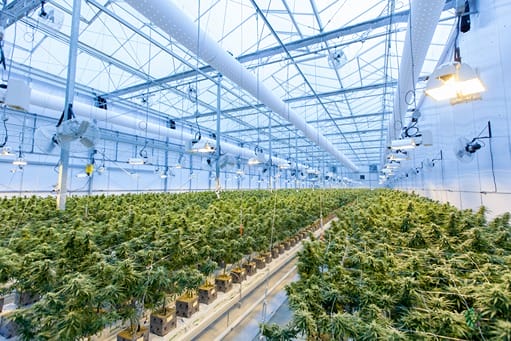
Ongoing research and the future of CBD
Researchers worldwide are dedicated to the more in-depth study of CBD to substantiate therapeutic claims. Every day, scientists discover promising aspects of this cannabis-based compound. Some of them explore its enormous potential in the treatment of neurodegenerative disorders such as Parkinson’s or amyotrophic lateral sclerosis (ALS). Others focus on its possible role in mitigating the side effects of chemotherapy. Here are some examples of recent studies:
• An article titled “Trial of Cannabidiol for Drug-Resistant Seizures in the Dravet Syndrome” by Devinsky and colleagues was published in The New England Journal of Medicine in 2017.
• Another clinical trial, “Evaluation of the Effects of Cannabidiol (CBD) Compared to Delta-9-Tetrahydrocannabinol (THC) and Alprazolam,” by the National Institute of Drug Abuse (NIDA) in the USA examines in detail the effects of Cannabidiol.
• A clinical Phase I trial ended at the end of 2019 with the research goal “Treatment of Chronic Pain With Cannabidiol (CBD) and Delta-9-tetrahydrocannabinol (THC).” Deborah Yurgelun-Todd of the University of Utah supervised this scientific study.


